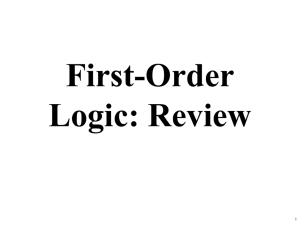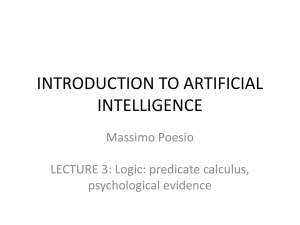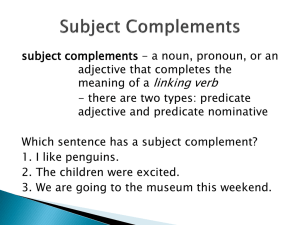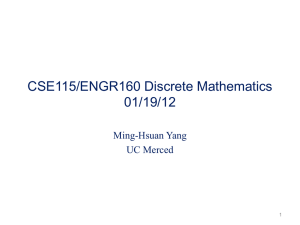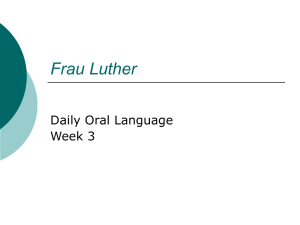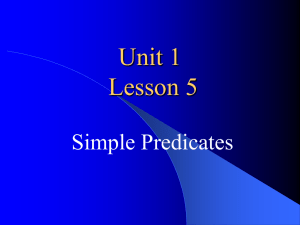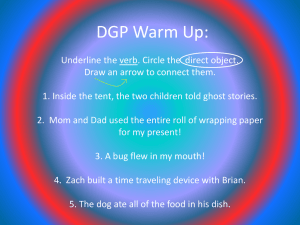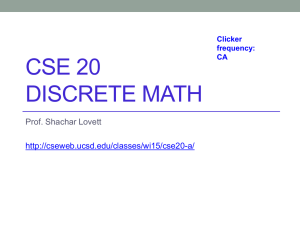Chapter 8
advertisement
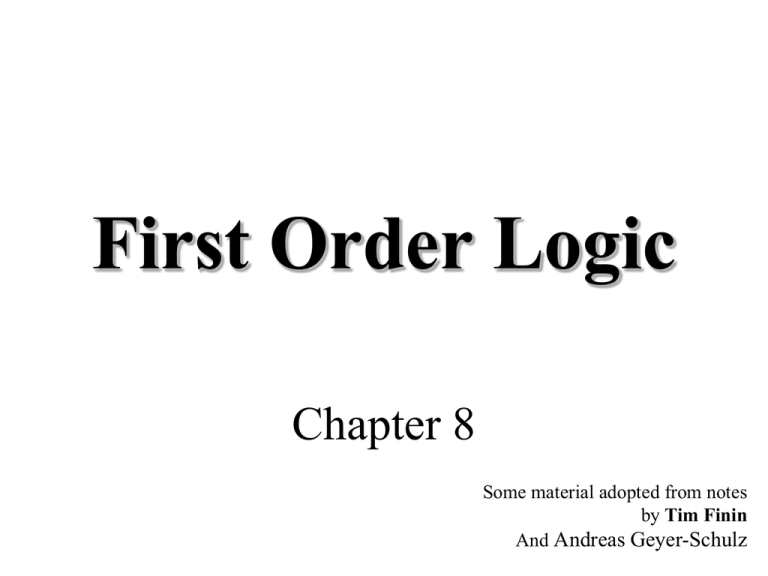
First Order Logic
Chapter 8
Some material adopted from notes
by Tim Finin
And Andreas Geyer-Schulz
First Order (Predicate) Logic (FOL)
• First-order logic is used to model the world in terms of
– objects which are things with individual identities
e.g., individual students, lecturers, companies, cars ...
– properties of objects that distinguish them from other objects
e.g., mortal, blue, oval, even, large, ...
– classes of objects (often defined by properties)
e.g., human, mammal, machine, ...
– relations that hold among objects
e.g., brother of, bigger than, outside, part of, has color, occurs
after, owns, a member of, ...
– functions which are a subset of the relations in which there is
only one ``value'' for any given ``input''.
e.g., father of, best friend, second half, one more than ...
Syntax of FOL
• Predicates: P(x1, ..., xn)
– P: predicate name;
(x1, ..., xn): argument list
– A special function with range = {T, F};
– Examples: human(x),
/* x is a human */
father(x, y) /* x is the father of y */
– When all arguments of a predicate are assigned values (said to be
instantiated), the predicate becomes either true or false, i.e., it
becomes a proposition. Ex. Father(Fred, Joe)
– A predicate, like a membership function, defines a set (or a class) of
objects
• Terms (arguments of predicates must be terms)
– Constants are terms (e.g., Fred, a, Z, “red”, etc.)
– Variables are terms (e.g., x, y, z, etc.), a variable is instantiated
when it is assigned a constant as its value
– Functions of terms are terms (e.g., f(x, y, z), f(x, g(a)), etc.)
– A term is called a ground term if it does not involve variables
– Predicates, though special functions, are not terms in FOL
• Quantifiers
Universal quantification (or forall)
– (x)P(x) means that P holds for all values of x in the
domain associated with that variable.
– E.g., (x) dolphin(x) => mammal(x)
(x) human(x) => mortal(x)
– Universal quantifiers often used with "implication (=>)" to
form "rules" about properties of a class
(x) student(x) => smart(x) (All students are smart)
– Often associated with English words “all”, “everyone”,
“always”, etc.
– You rarely use universal quantification to make blanket
statements about every individual in the world (because
such statement is hardly true)
(x)student(x)^smart(x) means everyone in the world is a
student and is smart.
Existential quantification
– (x)P(x) means that P holds for some value(s) of x in the domain
associated with that variable.
– E.g., (x) mammal(x) ^ lays-eggs(x)
(x) taller-than(x, Fred)
(x) UMBC-Student (x) ^ taller-than(x, Fred)
– Existential quantifiers usually used with “^ (and)" to specify a list
of properties about an individual.
(x) student(x) ^ smart(x) (there is a student who is smart.)
– A common mistake is to represent this English sentence as the
FOL sentence:
(x) student(x) => smart(x)
It also holds if there no student exists in the domain because
student(x) => smart(x) holds for any individual who is not a
student.
– Often associated with English words “someone”, “sometimes”, etc.
Scopes of quantifiers
• Each quantified variable has its scope
– (x)[human(x) => (y) [human(y) ^ father(y, x)]]
– All occurrences of x within the scope of the quantified x refer to the
same thing.
– Use different variables for different things
• Switching the order of universal quantifiers does not change the
meaning:
– (x)(y)P(x,y) ≡ (y)(x)P(x,y), can write as (x,y)P(x,y)
• Similarly, you can switch the order of existential quantifiers.
– (x)(y)P(x,y) ≡ (y)(x)P(x,y)
• Switching the order of universals and existential does change
meaning:
– Everyone likes someone: (x)(y)likes(x,y)
– Someone is liked by everyone: (y)(x) likes(x,y)
Sentences are built from terms and atoms
• A term (denoting a individual in the world) is a constant symbol,
a variable symbol, or a function of terms.
• An atom (atomic sentence) is a predicate P(x1, ..., xn)
– Ground atom: all terms in its arguments are ground terms (does not
involve variables)
– A ground atom has value true or false (like a proposition in PL)
• A literal is either an atom or a negation of an atom
• A sentence is an atom, or,
– ~P, P v Q, P ^ Q, P => Q, P <=> Q, (P) where P and Q are sentences
– If P is a sentence and x is a variable, then (x)P and (x)P are
sentences
• A well-formed formula (wff) is a sentence containing no "free"
variables. i.e., all variables are "bound" by universal or existential
quantifiers.
(x)P(x,y) has x bound as a universally quantified variable, but y is
free.
A BNF for FOL Sentences
S := <Sentence> ;
<Sentence> := <AtomicSentence> |
<Sentence> <Connective> <Sentence> |
<Quantifier> <Variable>,... <Sentence> |
~ <Sentence> |
"(" <Sentence> ")";
<AtomicSentence> := <Predicate> "(" <Term>, ... ")" |
<Term> "=" <Term>;
<Term> := <Function> "(" <Term>, ... ")" |
<Constant> |
<Variable>;
<Connective> := ^ | v | => | <=>;
<Quantifier> := | ;
<Constant> := "A" | "X1" | "John" | ... ;
<Variable> := "a" | "x" | "s" | ... ;
<Predicate> := "Before" | "HasColor" | "Raining" | ... ;
<Function> := "Mother" | "LeftLegOf" | ... ;
<Literal> := <AutomicSetence> | ~ <AutomicSetence>
Translating English to FOL
• Every gardener likes the sun.
(x) gardener(x) => likes(x,Sun)
• Not Every gardener likes the sun.
~((x) gardener(x) => likes(x,Sun))
• You can fool some of the people all of the time.
(x)(t) person(x) ^ (time(t) => can-be-fooled(x,t))
• You can fool all of the people some of the time.
(x)(t) person(x) ^ time(t) => can-be-fooled(x,t)
(x)(t) person(x) => time(t) ^ can-be-fooled(x,t)
(the time people are fooled may be different)
• You can fool all of the people at some time.
(t)(x) person(x) ^ time(t) => can-be-fooled(x,t)
(t)(x) time(t) ^ (person(x) => can-be-fooled(x,t))
(all people are fooled at the same time)
• You can not fool all of the people all of the time.
~((x)(t) person(x) ^ time(t) => can-be-fooled(x,t))
• Everyone is younger than his father
• All purple mushrooms are poisonous.
(x) (mushroom(x) ^ purple(x)) => poisonous(x)
• No purple mushroom is poisonous.
~(x) purple(x) ^ mushroom(x) ^ poisonous(x)
(x) (mushroom(x) ^ purple(x)) => ~poisonous(x)
• There are exactly two purple mushrooms.
(x)(Ey) mushroom(x) ^ purple(x) ^ mushroom(y) ^ purple(y) ^
~(x=y) ^
(z) (mushroom(z) ^ purple(z)) => ((x=z) v (y=z))
• Clinton is not tall.
~tall(Clinton)
• X is above Y if X is directly on top of Y or there is a pile
of one or more other objects directly on top of one
another starting with X and ending with Y.
(x)(y) above(x,y) <=> (on(x,y) v (z) (on(x,z) ^ above(z,y)))
Connections between Forall and Exists
• “It is not the case that everyone is ...” is logically
equivalent to “There is someone who is NOT ...”
• “No one is ...” is logically equivalent to “All people
are NOT ...”
• We can relate sentences involving forall and exists
using De Morgan’s laws:
~(x)P(x) (x) ~P(x)
~(x) P(x) (x) ~P(x)
(x) P(x) ~(x) ~P(x)
(x) P(x) ~ (x) ~P(x)
• Example: no one likes everyone
– ~ (x)(y)likes(x,y)
– (x)(y)~likes(x,y)
Semantics of FOL
• Domain M: the set of all objects in the world (of interest)
• Interpretation I: includes
– Assign each constant to a domain element (an object in M)
– Define each function of n arguments as a mapping M^n => M
– Define each predicate of n arguments as a mapping M^n => {T, F}
Therefore, every ground predicate with any instantiation will have a
truth value
– In general there are infinite number of interpretations because |M| is
infinite
• Define semantics of logical connectives: ~, ^, v, =>, <=> as in PL
• Define semantics of (x) and (x)
– (x) P(x) is true iff P(x) is true under all extended interpretations
– (x) P(x) is true iff P(x) is true under some extended interpretation
– Extended interpretation: assign a domain element to x.
• Model: an interpretation of a set of sentences such that every
sentence is True
• A sentence is
– satisfiable if it is true under some interpretation
– valid if it is true under all possible interpretations
– inconsistent if there does not exist any interpretation under which the
sentence is true
• logical consequence: S |= X if all models of S are also models of
X
Axioms, definitions and theorems
•Axioms are facts and rules which are known (or assumed) to
be true facts and concepts about a domain.
–Mathematicians don't want any unnecessary (dependent) axioms
-- ones that can be derived from other axioms.
–Dependent axioms can make reasoning faster, however.
–Choosing a good set of axioms for a domain is a kind of design
problem.
•A definition of a predicate is of the form “P(x) <=> S(x)”
(define P(x) by S(x)) and can be decomposed into two parts
–Necessary description: “P(x) => S(x)” (only if)
–Sufficient description “P(x) <= S(x)” (if)
–Some concepts don’t have complete definitions (e.g. person(x))
•A theorem S is a sentence that logically follows the axiom
set A, i.e. A |= S.
More on definitions
• A definition of P(x) by S(x)), denoted (x) P(x) <=> S(x), can be
decomposed into two parts
– Necessary description: “P(x) => S(x)” (only if, for P(x) being true,
S(x) is necessarily true)
– Sufficient description “P(x) <= S(x)” (if, S(x) being true is sufficient
to make P(x) true)
• Examples: define father(x, y) by parent(x, y) and male(x)
– parent(x, y) is a necessary (but not sufficient ) description of
father(x, y)
father(x, y) => parent(x, y), parent(x, y) => father(x, y)
– parent(x, y) ^ male(x) is a necessary and sufficient description of
father(x, y)
parent(x, y) ^ male(x) <=> father(x, y)
– parent(x, y) ^ male(x) ^ age(x, 35) is a sufficient (but not necessary)
description of father(x, y) because
father(x, y) => parent(x, y) ^ male(x) ^ age(x, 35)
More on definitions
S(x) is a
necessary
condition of P(x)
P(x)
S(x) is a
sufficient
condition of P(x)
S(x)
S(x) is a
necessary and
sufficient
condition of P(x)
P(x)
(x) P(x) => S(x)
S(x)
(x) P(x) <= S(x)
P(x)
S(x)
(x) P(x) <=> S(x)
Example: A simple genealogy KB by FOL
• Build a small genealogy knowledge base by FOL that
– contains facts of immediate family relations (spouses, parents, etc.)
– contains definitions of more complex relations (ancestors, relatives)
– is able to answer queries about relationships between people
• Predicates:
–
–
–
–
parent(x, y), child (x, y), father(x, y), daughter(x, y), etc.
spouse(x, y), husband(x, y), wife(x,y)
ancestor(x, y), descendent(x, y)
relative(x, y)
• Facts:
–
–
–
–
–
husband(Joe, Mary), son(Fred, Joe)
spouse(John, Nancy), male(John), son(Joe, Nancy)
father(Jack, Nancy), daughter(Linda, Jack)
daughter(Liz, Linda)
etc.
• Rules for genealogical relations
– (x,y) parent(x, y) <=> child (y, x)
(x,y) father(x, y) <=> parent(x, y) ^ male(x) (similarly for mother(x, y))
(x,y) daughter(x, y) <=> child(x, y) ^ female(x) (similarly for son(x, y))
– (x,y) husband(x, y) <=> spouse(x, y) ^ male(x) (similarly for wife(x, y))
(x,y) spouse(x, y) <=> spouse(y, x) (spouse relation is symmetric)
– (x,y) parent(x, y) => ancestor(x, y)
(x,y)(z) parent(x, z) ^ ancestor(z, y) => ancestor(x, y)
– (x,y) descendent(x, y) <=> ancestor(y, x)
– (x,y)(z) ancestor(z, x) ^ ancestor(z, y) => relative(x, y)
(related by common ancestry)
(x,y) spouse(x, y) => relative(x, y) (related by marriage)
(x,y)(z) relative(x, z) ^ relative(z, y) => relative(x, y) (transitive)
(x,y) relative(x, y) => relative(y, x) (symmetric)
and similarly son(x, y), mother(x, y), wife(x, y)
• Queries (based on facts from the previous page)
– ancestor(Jack, Fred) /* the answer is yes */
– relative(Liz, Mary)
/* the answer is yes */
– relative(Nancy, Mathews)
/* no answer in general, no if under closed world assumption */
Higher order logic
• FOL only allows to quantify over variables, and variables
can only range over objects.
• HOL allows us to quantify over relations
• Example: (quantify over functions)
“two functions are equal iff they produce the same value for all
arguments”
f g (f = g) <=> (x f(x) = g(x))
• Example: (quantify over predicates)
r transitive( r ) => (xyz) r(x,y) ^ r(y,z) => r(x,z))
• More expressive, but undecidable.
Representing Change
• Representing change in the world in logic can be
tricky.
• One way is to change the KB
– add and delete sentences from the KB to reflect changes.
– How do we remember the past, or reason about changes?
• Situation calculus is another way
• A situation is a snapshot of the world at some
instant in time
• When the agent performs an action A
in situation S1, the result is a new
situation S2.
Situations
Situation Calculus
• A situation is a snapshot of the world at an interval of time when
nothing changes
• Every true or false statement is made with respect to a particular
situation.
– Add situation variables to every predicate. E.g., feel(x, hungry)
becomes feel(x, hungry, s0) to mean that feel(x, hungry) is true in
situation (i.e., state) s0.
– Or, add a special predicate holds(f,s) that means "f is true in
situation s.” e.g., holds(feel(x, hungry), s0)
• Add a new special function called result(a,s) that maps current
situation s into a new situation as a result of performing action a. For
example, result(eating, s) is a function that returns the successor state
in which x is no longer hungry
• Example: The action of eating could be represented by
• (x)(s)(feel(x, hungry, s) => feel(x, not-hungry,result(eating(x),s))
Frame problem
• An action in situation calculus only changes a small portion of
the current situation
– after eating, x is not-hungry, but many other properties related to x
(e.g., his height, his relations to others such as his parents) are not
change
– Many other things unrelated to x’s feeling are not changed
• Explicit copy those unchanged facts/relations from the current
state to the new state after each action is inefficient (and
counterintuitive)
• How to represent facts/relations that remain unchanged by
certain actions is known as “frame problem”, a very tough
problem in AI
• One way to address this problem is to add frame axioms.
– (x,s1,s2)P(x, s1)^s2=result(a(s1)) =>P(x, s2)
• We may need a huge number of frame axioms
Qualification problem
• Qualification problem:
– How can you possibly characterize every single effect of
an action, or every single exception that might occur?
– When I put my bread into the toaster, and push the
button, it will become toasted after two minutes,
unless…
•
•
•
•
The toaster is broken, or…
The power is out, or…
I blow a fuse, or…
A neutron bomb explodes nearby and fries all electrical
components, or…
• A meteor strikes the earth, and the world we know it ceases to
exist, or…
Ramification problem
• Similarly, it’s just about impossible to characterize every side
effect of every action, at every possible level of detail:
– When I put my bread into the toaster, and push the button, the bread
will become toasted after two minutes, and…
• The crumbs that fall off the bread onto the bottom of the toaster over
tray will also become toasted, and…
• Some of the aforementioned crumbs will become burnt, and…
• The outside molecules of the bread will become “toasted,” and…
• The inside molecules of the bread will remain more “breadlike,” and…
• The toasting process will release a small amount of humidity into the
air because of evaporation, and…
• The heating elements will become a tiny fraction more likely to burn
out the next time I use the toaster, and…
• The electricity meter in the house will move up slightly, and…
